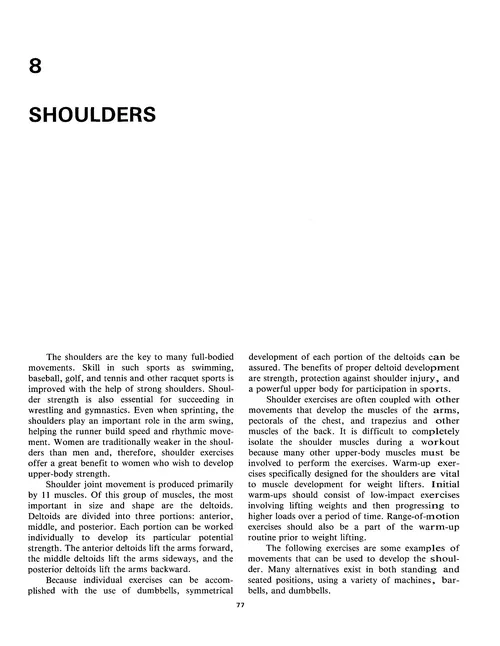
8 SHOULDERS
After 72 hours, ice the shoulder after activity or exercise. I. Ice. You should rest from all activities that cause shoulder pain. Consider.
adsPart of the document
8
SHOULDERS
The shoulders are the key to many full-bodied
movements. Skill in such sports as swimming,
baseball, golf, and tennis and other racquet sports is
improved with the help of strong shoulders. Shoul-
der strength is also essential for succeeding in
wrestling and gymnastics. Even when sprinting, the
shoulders play an important role in the arm swing,
helping the runner build speed and rhythmic move-
ment. Women are traditionally weaker in the shoul-
ders than men and, therefore, shoulder exercises
offer a great benefit to women who wish to develop
upper-body strength.
Shoulder joint movement is produced primarily
by 11 muscles. Of this group of muscles, the most
important in size and shape are the deltoids.
Deltoids are divided into three portions: anterior,
middle, and posterior. Each portion can be worked
individually to develop its particular potential
strength. The anterior deltoids lift the arms forward,
the middle deltoids lift the arms sideways, and the
posterior deltoids lift the arms backward.
Because individual exercises can be accom-
plished with the use of dumbbells, symmetrical
development of each portion of the deltoids can be
assured. The benefits of proper deltoid development
are strength, protection against shoulder injury, and
a powerful upper body for participation in sports.
Shoulder exercises are often coupled with other
movements that develop the muscles of the arms,
pectorals of the chest, and trapezius and other
muscles of the back. It is difficult to completely
isolate the shoulder muscles during a workout
because many other upper-body muscles must be
involved to perform the exercises. Warm-up exer-
cises specifically designed for the shoulders are vital
to muscle development for weight lifters. Initial
warm-ups should consist of low-impact exercises
involving lifting weights and then progressing to
higher loads over a period of time. Range-of-motion
exercises should also be a part of the warm-up
routine prior to weight lifting.
The following exercises are some examples of
movements that can be used to develop the shoul-
der. Many alternatives exist in both standing and
seated positions, using a variety of machines, bar-
bells, and dumbbells.


